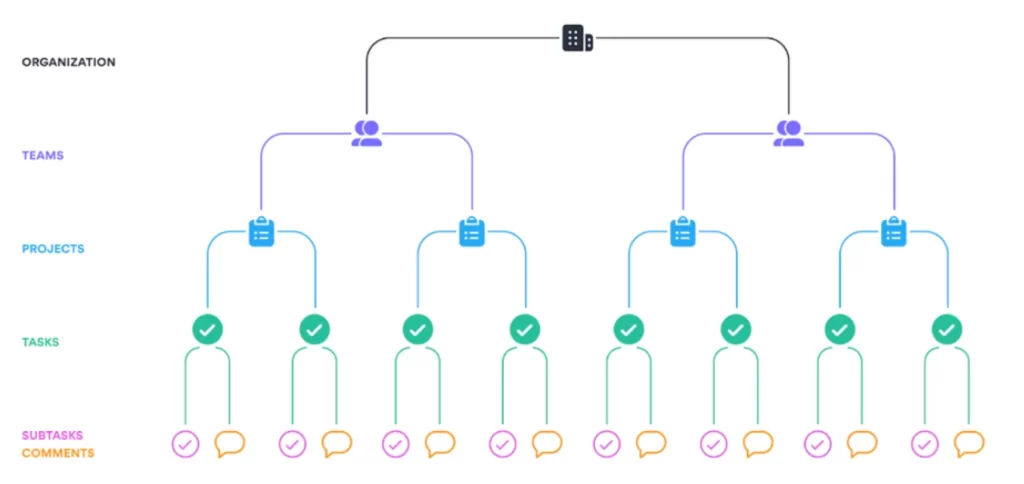Many new Asana users ask “How do I slow down the noise of too many notifications in Asana?” Asana is a communication and collaboration tool, so it’s important to receive notifications when changes are made on the platform. But many times users are unaware of how to disable duplicated notifications or even remove themselves from projects and tasks they no longer need to be informed about.
Thankfully, Asana gives you many options to choose from when customizing your notification settings. You will decide where you want your notifications to land, what kind of notifications you want to receive, and how often you want to receive them.
Notification Know-How: Where, When, and How
Where
Asana lets you receive notifications in three different places: in your Asana Inbox, email, and as browser notifications. When you first begin using Asana, the default setting is that all notifications come to both your Asana Inbox and your Email. Browser notifications are disabled by default. It’s best to leave browser notifications turned off for maximum productivity, but the option to get notified in your browser is there if you need it.
My first recommendation for teams is to disable notifications to your email. BUT only after you and your team have agreed to faithfully check your Asana Inbox 2-3 times each day for updates on your work. This builds trust among your team that everyone sees your communication about collaborative work. Disabling your email notifications without the commitment to check your Asana Inbox consistently will spell disaster for your team. You will lose work without the updates you receive from your Asana Inbox.
When
Deciding when you see your notifications is up to you. If you disable email notifications, you will simply choose which parts of the day you will check your Asana Inbox and act on new notifications you receive. An easy plan to follow is to go into your Asana Inbox when you begin your day, in the middle of your day, and before you end your day.
Each time you check your Inbox, you will be able to see changes made by others to the work you are doing and even act on those changes right there in your Asana Inbox. You can “like” an action, ask a question in the comments of a task, or even throw out some Asana celebration for a well-done task.
How
Once you decide how you want your notifications to come to you, how do you tell Asana your wishes? You simply click on your profile picture and choose the “settings” in the list. Once there, go to the second tab, “Notifications.” There you will find the option to “uncheck” all the boxes related to receiving email notifications. As you scroll to the bottom of the screen you will see the option to tell Asana which project notifications you want to receive. It even gives you the option to customize this setting per individual project. More on that a bit later.
Notification Types
Now that you understand the where, when, and how of notifications in Asana, let’s look at the types of notifications you can receive. Remember Asana’s structure starts with the full Asana Organization, followed by Asana Teams, then Asana Projects, and finally Asana Tasks. We’ll take a look at what kinds of notifications you can receive at each level.

Notifications in Asana Teams
Each Asana Team will have its own members. Those members will receive a notification when someone sends a message to the full team. This can be done from the team page, messages tab, or simply by using the orange “plus” button (called the Omnibutton by Asana) and choosing Message. From there, you will type the name of the Team you wish to message and pick it from a dropdown. This option is best used when discussing something relevant to the full team.
From the Asana Inbox, you can respond to that message. If you no longer need to receive notifications related to that message, you can remove yourself from the thread simply by clicking on the bell at the bottom of the screen. This will remove you from the message without removing you from the team.
If someone leaves a comment on the message, the original sender, any other previous commenters, and anyone who has been @mentioned in the comments will be notified. These people are the “collaborators” on the message. Just as before, a collaborator can also remove himself easily. Simply click on the “x” next to your picture at the bottom of the message.
Notifications in Asana Projects
Similar to an Asana Team, an Asana Project will have members. If a message is sent within an Asana project, all members of that project will receive an initial notification. If there is a response to that message, the original sender and any who have been @mentioned will be notified. These collaborators can easily remove themselves from the message using the “x” next to their picture if they no longer wish to receive notifications about that specific message.
As we mentioned in the Know-How section above, you have the option to tell Asana which project notifications you want to receive. Simply go to your profile and select “settings.” From there, choose the “notifications” tab. Scroll to the bottom of that screen and you can check/uncheck the default setting for all projects that you are a part of.
I suggest you choose to receive status updates as these will keep you informed of the overall progress of the project as the project owner adds the update. Messages should be kept checked for the most up-to-date questions and information for the full project. Most people can uncheck the Tasks Added box. If the task is assigned to you, you will see the task in your My Tasks list. If it is not assigned to you, there may be no reason for you to receive notifications. Of course, you can always see every task when you view the whole project.
If you need to customize a specific project’s settings, you can do that by clicking on the “Manage Individual Projects” button. There may be some projects that you want to see when tasks are added. Simply check the box next to the project where you want to apply the setting.
Notifications in Asana Tasks
When you are the creator or assignee of an Asana Task, you will receive Asana Inbox notifications for that task. As with messages, if you no longer wish to receive notifications on each change to a task, you can simply remove yourself as a collaborator of the task by clicking on the “x” next to your picture at the bottom of the task pane.
As a collaborator on a task, you will receive notifications when:
- A task is assigned to you
- A task is unassigned from you
- A task assigned to you has its due date changed
- You have been added as a follower of a task
- A task you are following has new files
- A task you are following has new comments
- A task you are following is marked complete
- A task you are following is given a like
- Your comment is liked
- Your attachment is liked
- Your task completion is liked
- The status of a task you’ve been waiting on has been changed
- A task is moved from one column to another in a Board’s project
- You have been assigned a task to approve
If you are the initiator of any of the above actions, you will not receive a notification in your Asana Inbox. Remember, notifications are a communication tool, so there is no need to see a notification when you take an action personally. However, staying up to date on changes made by others is important to the collaboration efforts of your co-workers. Remember that you can remove yourself as a collaborator on any task at any time if the notifications are too noisy.
Acting on your notifications
As mentioned earlier, each team member checking notifications 2-3 times daily is a common best practice in Asana. So what should happen when you check notifications?
When you click to view your Asana Inbox, you will have a left pane and a right pane on your screen. The left pane is your list of notifications with the most recent at the top. The right pane will hold the task that the selected notification pertains to. This allows you to take action directly on that task without going back to the project to find it.
If you need to add a comment, like, or complete the task, simply do that right in your Inbox. Once you have taken action on the task, you can click on the top right side of the notification itself to archive the notification. This simply moves it from your Inbox so that you can keep that space clean.
Another option on your notification is to mark it unread. This happens when you want to make sure you see that notification again and take action on it later. You can also take action on notifications by creating a follow-up task. This will allow you to create a completely new task from your Inbox screen that will have the correlated task linked.
Once you have taken the action needed, you should always archive the notification. This allows you to stay up to date with communication happening in Asana and get your notifications to “inbox zero” each time you check it.
One final option in your Asana Inbox is to filter your view. You can easily see your notifications filtered by:
- Assigned to Me
- @ Mentioned
- Assigned by Me
If you have a large number of notifications and you are looking for something very specific, these filters will help you find it quickly.
Final Thoughts
Notifications in Asana are a tool to facilitate communication and collaboration for teams. However, when not managed well, they can soon become a noisy problem. Start by committing to checking your Asana Inbox 2-3 times daily and taking action on those notifications. You can then remove all email notifications to quieten the noise in your Email.
For further exploration of Asana notifications, check out Module 4 of the Asana Simplified course for small business.
or head to:
For more helpful Asana-related topics, head to Tessera’s Asana Helps.

About the Author
Paula Holsberry is the founder of Tessera Virtual Business Solutions, specializing in optimizing work processes for remote teams. With experience in both start-ups and larger companies, she helps teams maximize productivity through efficient Asana training and consulting.


